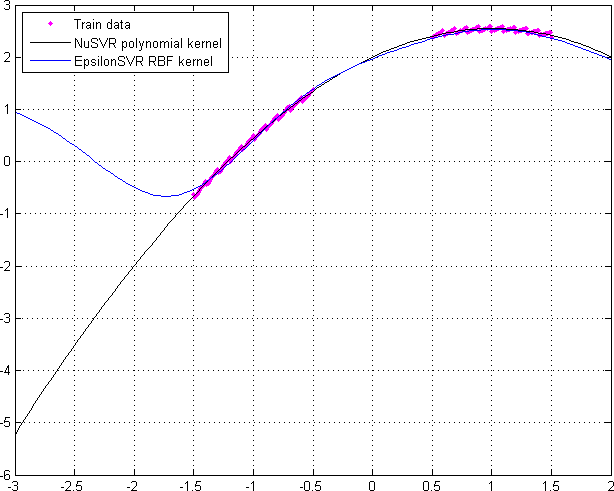SVM Vector Regression |
ϵ-Support Vector Regression
Consider a set of training points  , where
, where  is a feature vector and
is a feature vector and  is the target output. Under given parameters
is the target output. Under given parameters  and
and  , the standard form of support vector regression (V. Vapnik. Statistical Learning Theory. Wiley, New York, NY, 1998) is
, the standard form of support vector regression (V. Vapnik. Statistical Learning Theory. Wiley, New York, NY, 1998) is
 ,
,
subject to  ,
,


 ,
,



ν-Support Vector Regression
Similar to ν-SVC, for this regression (B. Schölkopf, A. Smola, R. C. Williamson, and P. L. Bartlett. New support vector algorithms.
Neural Computation, 12:1207–1245, 2000) a parameter ν∈( 0,1] to control the number of support vectors.
The parameter ϵ in ϵ-SVR becomes a parameter here. With  as parameters, ν-SVR solves
as parameters, ν-SVR solves
 ,
,
subject to  ,
,





 ,
,

Examples
As you can see from the following example, the proper kernel function selection plays key role in proper regression design: in [-1.5,2] range these two functions look nearly the same, but out of training region their behavior differs significantly.

SVMRegression class contains SVMRegressionTypeRegression enumeration which is used to set ϵ- or ν-Support Type. The following methods are featured in the class:
Method | Description | Performance |
|---|---|---|
train ϵ-support | Train ϵ - Support Vector Regression. | |
train ν-support | Train ν - Support Vector Regression. | |
classify | Predicts value in observation point. |
The example of SVM Vector Regression usage:
1public static void RegressionTest() 2{ 3 Console.WriteLine("********************************************************************"); 4 Console.WriteLine("RegressionTest"); 5 Console.WriteLine("********************************************************************"); 6 7 // Build observation matrices 8 Matrix xz = new Matrix(101 * 2, 1); 9 for (int i = 0; i < xz.Rows / 2; ++i) 10 { 11 xz[i, 0] = -1.5 + i / 100.0; 12 xz[i + 101, 0] = -(-1.5 + i / 100.0); 13 } 14 15 Vector yz = new Vector(xz.Rows); 16 for (int i = 0; i < xz.Rows; ++i) 17 { 18 Double x = xz[i, 0]; 19 yz[i] = -0.5 * x * x + x + 2 + ((x * 10) % 1) / 10; 20 } 21 22 Matrix tz = new Matrix(151, 1); 23 for (int i = 0; i < tz.Rows; ++i) 24 tz[i, 0] = -3 + i / 30.0; 25 26 27 SVMRegression model = new SVMRegression(); 28 model.TrainNuSVR(xz, yz, false, kernel: new FMSVM.KernelPolynomial(coef0: 10)); 29 model.Save("svm_s4t1r10_cpp"); 30 31 Double pred_val; 32 for (int ri = 0; ri < tz.Rows; ++ri) 33 pred_val = model.Classify(tz.GetRow(ri)); 34 Console.WriteLine($"Model {model.Type} with kernel {model.Kernel}"); 35 36 37 model.TrainEpsilonSVR(xz, yz); 38 model.Save("svm_s3t2_cpp"); 39 40 for (int ri = 0; ri < tz.Rows; ++ri) 41 pred_val = model.Classify(tz.GetRow(ri)); 42 Console.WriteLine($"Model {model.Type} with kernel {model.Kernel}"); 43}
